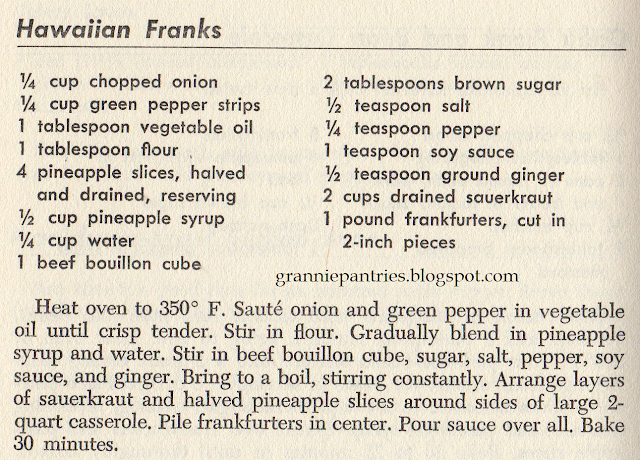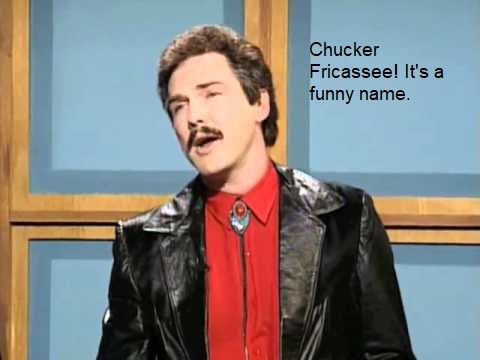Wednesday, March 30, 2022
Getting dragged through the neighborhood with the intolerable Miss Vickie
Saturday, March 26, 2022
Funny Name: "Genuinely" Funni Edition
Wednesday, March 23, 2022
A cookbook that tells you what to do if you've got too much pig or not enough of it
Saturday, March 19, 2022
Vegging out in 1950
Wednesday, March 16, 2022
Looking into the Mirro
Saturday, March 12, 2022
Watch some Smart Shoppers try to go "meatless"
For Lent, I thought maybe we could do a bit of a deep dive on the "meatless" dishes in Smart Shopper's Cookbook (Loyta Wooding, 1972). So let's check out what those with serious budgeting concerns would do when the menu wouldn't allow for meat and/or the church dictated meatless Fridays.
Here's one of the first recipes in the meatless chapter:
And it appears that Wooding's definition of "meatless" does not coincide with most people's, as this recipe starts out with bacon (and there was no popping down to the grocery for a vegan bacon substitute back in 1972). Even worse, though, after sautéing the bacon, the cook is instructed to discard the bacon drippings and to cook up the rest of the dish in margarine! If you're going to go to the trouble of cooking bacon for something supposedly meatless and this is supposed to be a budget book anyway, why not use the bacon fat as the cooking oil? It boggles the mind. Why should cooks spend extra money for inferior flavor?
Okay, on to the actually meatless meatless dishes. Of course, there is the standard array of loaves, from the expected combination of various veggies and beans held together with eggs and baked into a brick...
...to the slightly less orthodox combo of peanut butter and lima beans with American cheese and tomato sauce...
...to the not-too-bad sounding spaghetti baked into a macaroni-and-cheese-esque custard.
Or, if you want your macaroni and cheese in bite-sized form, there's Macaroni Patties.
(Use them as a side dish for pot roast if you've forgotten the meatless conceit.)
If you can't survive without a gelatin-based side, you can get extra protein from the Tomato Cottage Cheese Salad.
It's made with lemon Jell-O instead of unflavored gelatin and loaded up with cabbage and onion as well, so it's sure to be a memorable treat.
And if you need a festive cake to finish things off, but you've sworn off sweets as well, you're in luck! We can end with the Upside-Down Vegetable Cake.
Maybe the family will be unhappy that it's not dessert, but it's still fresh, hot, homemade bread, and they can cover their pieces with tomato sauce and pretend it's glaze! I'm not sure whether '70s moms could sell that idea with enough conviction to make it work, but I'd have liked to see them try.
Wednesday, March 9, 2022
Smart? Maybe... but at least it's entertaining
Saturday, March 5, 2022
Funny Name: I Hope the Title Isn't the Effect Edition
Wednesday, March 2, 2022
When the Carbs Come Marching in
March means that I've been yelling "Yeah! It's winter! I get the idea!" for several straight months now. And the world has generally been indifferent. So let's check in with Cincinnati Celebrates: Cooking and Entertaining for All Seasons (Junior League of Cincinnati, first printing August, 1974, though mine is from the 1980 fifth printing) to see how the Junior Leaguers recommend dealing with the wintertime blues.
They say to have a Calico Bridge Luncheon. I'm not sure how authentic Swiss Cheese Bread and Angel Pie are to "pioneer Americana," but considering the group's ideas of "early America" for February's Presidents' Day celebration, I wasn't expecting much.
There's no Sherry Cobbler recipe, so I assume the ladies liked the usual sherry/ simple syrup/ orange wheel combo, as long as there was enough sherry to make them forget, however briefly, that it was still winter.
I thought that Junior League types might have been wary of carbs, but the rest of the menu suggests they longed for carbs just as much as anyone else holed up for a midwest winter. Hungarian Rye Bread Soup is just what it sounds like: soup made out of rye bread.
The rye bread is puréed not just into bouillon, but into bouillon fortified with instant mashed potatoes for that extra carby boost early March requires.
And if the bread soup is not enough, well, there's non-soggy bread to go with it.
Add a few marinated veggies to balance things out with some acidified carbs.
And then finish it all off with some sweet and fluffy carbs.
This menu shows the Junior League had the same instincts as pretty much everybody else by this point in the year: hole up in the den and put yourself into an alcohol-and-carb coma until it's at least possible to trick yourself into believing that spring is coming....



















































